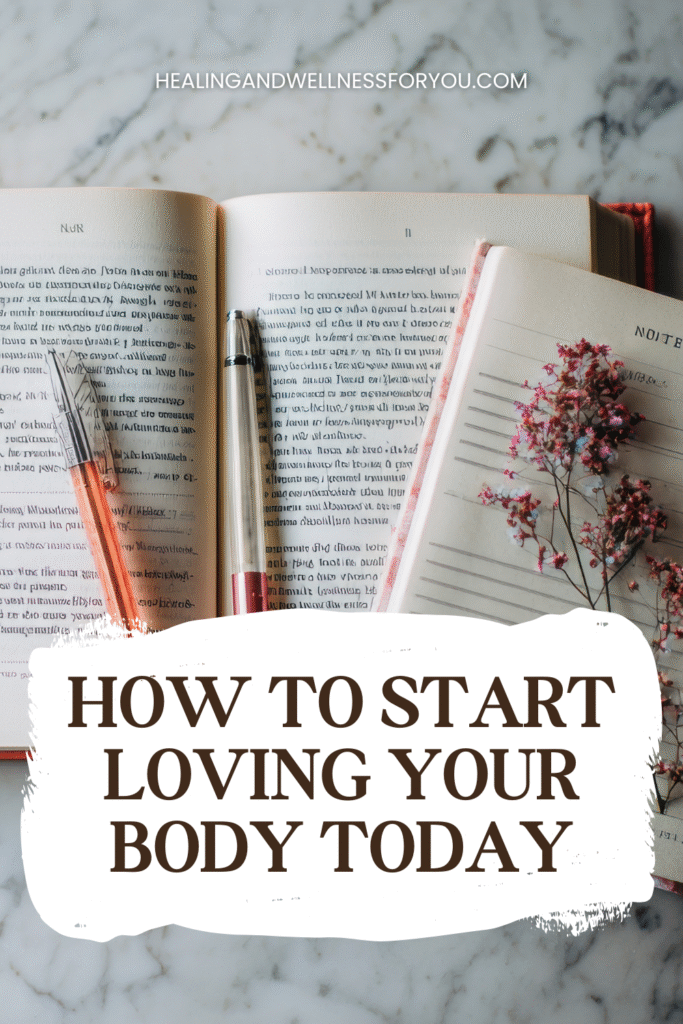Positive Body Affirmations: 50 Empowering Words to Boost Self-Love and Body Confidence Every Day
Positive Body Affirmations: 50 Empowering Words to Boost Self-Love and Body Confidence Every Day

We all have days when it’s hard to feel good about our appearance.
Negative thoughts can creep in and shape the way we see ourselves.
Positive body affirmations offer us simple yet powerful words that shift our focus toward acceptance, confidence, and self-love.
We can use affirmations to remind ourselves that our worth isn’t tied to size, shape, or appearance. By doing so, we create a healthier mindset that supports both our mental and physical well-being. When we practice daily, these statements can help us build habits of kindness toward ourselves.
Let’s explore what positive body affirmations are, why they matter, and how to use them in everyday life. I’ll share examples you can start using right away, tips for creating your own, and even the science behind why they work.
What Are Positive Body Affirmations and Why Do They Matter?
Positive body affirmations help us build a healthier relationship with how we see ourselves. They encourage us to replace negative self-talk with kinder thoughts, which can improve confidence, self-respect, and daily well-being.

Body affirmations are short, positive statements we repeat to ourselves about our bodies. These phrases emphasize acceptance, appreciation, and respect over appearance.
Unlike vague compliments, affirmations target specific thoughts, such as “I am grateful for my body’s strength” or “My body deserves care and kindness.” By repeating them, we shift our inner dialogue from criticism to kindness.
Many people incorporate affirmations into their self-care routines. For example, say them in the morning, during exercise, or before bed. They act as simple reminders that our bodies are valuable beyond size, shape, or weight.
Affirmations are not about ignoring health goals – they help us approach our goals with compassion rather than shame. This makes them a practical tool for building body confidence and self-acceptance.
Benefits of Using Affirmations
Practicing body affirmations can reduce negative self-talk, which often harms self-esteem. When we repeat positive affirmations, we create space for more supportive thoughts.
Research indicates that affirmations can enhance mood and boost motivation. For example, body-positive affirmations may help us feel more comfortable in our own skin, which can lead to healthier behaviors, such as balanced eating and regular movement.
Some benefits include:
- Improved body image: We view our bodies more realistically and with kindness
- Lower stress: Positive self-talk reduces the pressure of comparison
- Better self-care: We treat our bodies with more respect and patience
Affirmations also support mental health by lowering the intensity of negative emotions. Over time, this can make us more resilient when facing body-related challenges.
How Affirmations Rewire the Brain
Affirmations work because our brains respond to repeated thoughts.
When we repeat positive body affirmations, we strengthen new thought patterns and weaken old ones.
This process is linked to neuroplasticity, the brain’s ability to form new connections. Studies suggest that affirmations can activate brain regions tied to self-worth and problem-solving.
For example, positive body image affirmations may help us replace automatic negative thoughts with healthier beliefs. Instead of focusing on flaws, we begin to notice strengths and abilities.
Over time, these new patterns become habits. Our inner voice shifts from critical to encouraging, which makes it easier to maintain confidence in daily life.
By practicing consistently, we train our minds to support us rather than hold us back. This is why affirmations are more than words—they are tools for reshaping how we think and feel about our bodies.
How to Use Positive Body Affirmations Effectively
We can use affirmations in simple, practical ways that fit into our daily lives. By incorporating them into our habits, we train our minds to shift from negative self-talk to kinder, more supportive thoughts that help us feel balanced and assured.
Incorporate Them into Daily Routines
Adding affirmations to routines makes them easier to remember. We can say them while brushing our teeth, stretching in the morning, or cooking a meal. This way, affirmations become part of what we already do instead of something extra we have to plan. Simplicity is key!
For example, while preparing breakfast, we might say, “I nourish my body with care and respect.” Pairing affirmations with regular tasks helps us connect positive self-talk to everyday life.
We can also keep a short list of affirmations in places we see often, like taped to the bathroom mirror or saved as a phone note. This makes it natural to repeat them without forcing the habit.
Practice Mindfulness with Affirmations
Mindfulness means paying attention to what we think and feel in the present moment. When we say affirmations, it helps to slow down, breathe, and notice how the words affect us.
Instead of rushing through them, we can pause and let each phrase sink in. For example, if we say, “My body deserves kindness,” we can notice how that feels in our chest or shoulders.
We might even close our eyes while repeating affirmations to stay focused. Practicing this way turns affirmations into more than just words—it makes them part of how we connect with ourselves.
Repeat Affirmations Consistently
Consistency matters more than the number of affirmations we use. Repeating them daily builds new thought patterns that replace negative self-talk.
We can start with just one or two phrases and repeat them at the same time each day. For instance, we might say, “I accept my body as it is,” every morning before leaving the house.
Using a steady rhythm or repeating affirmations out loud can make them easier to remember. Over time, this practice helps us shift our mindset in a lasting way.
Use Visual Reminders
Visual cues keep affirmations fresh in our minds. Sticky notes on mirrors, wallpaper on our phone, or a card on our desk can remind us to pause and repeat them.
We can also write affirmations in a journal and decorate them with colors or drawings. This makes the process feel more personal and engaging.
For extra support, we might create a small chart to track our practice of affirmations. A simple table like this can help:
| Day | Affirmation | Mood |
| Monday | “I nourish my body” | Felt calm |
| Tuesday | “I am enough” | More focused |
50 Positive Body Affirmations to Boost Self-Love and Confidence
- I love my body and all it does for me
- My body is strong, capable, and worthy of care
- Every curve, line, and feature makes me unique
- I release judgment and welcome self-acceptance
- My body is a beautiful expression of my soul
- I deserve to feel confident in my skin every day
- I appreciate the strength in my muscles and bones
- My body allows me to experience the world fully
- I choose to see myself with loving, gentle eyes
- My scars, marks, and lines tell the story of my strength
- I give myself permission to feel good in my body
- My worth is not measured by a number on a scale
- I honor the changes my body goes through
- My body is worthy of love at every stage of life
- I radiate beauty that comes from within
- My body deserves rest, balance, and care
- I celebrate the uniqueness of my body’s design
- My inner light makes me glow outwardly
- I love my body for carrying me through each day
- I choose to focus on progress, not perfection
- My self-confidence grows stronger every day
- My body communicates with me, and I listen
- I treat my body with patience and kindness
- I am more than my physical appearance.
- My body is a reflection of resilience and strength
- I accept myself unconditionally
- I give thanks for my body’s ability to heal
- My body allows me to hug, dance, laugh, and love
- I am grateful for the energy my body gives me
- I choose to release shame and embrace joy
- My body is not a problem to fix—it is a gift to cherish
- I celebrate the power of my breath and heartbeat
- I feel grounded and safe in my body
- My reflection is a reminder of my inner strength
- I allow my body to be at peace
- Every cell in my body vibrates with love
- I am comfortable in the skin I am in
- I honor the cycles and rhythms of my body
- I give myself permission to love all of me
- My natural beauty is radiant and effortless
- I thank my body for all it has carried me through
- I feel at home within myself
- My body is capable of amazing things
- I trust my body’s wisdom and intuition
- I release comparisons and honor my own journey
- My body reflects the love and care I give it
- I see beauty when I look in the mirror
- My body and mind work together in harmony
- I honor the softness and strength within me
- I am proud of the body I have today
Tips for Creating Your Own Positive Body Affirmations
When we create affirmations, we focus on what we want to believe about ourselves and how we want to treat our bodies. The goal is to build language that supports self-acceptance, confidence, and growth in a way that feels natural and realistic.
Identify Areas Where You Seek Growth
Start by thinking about the aspects of your body image or self-talk that feel the most challenging to manage. Maybe we compare ourselves to others, dislike certain features, or struggle to feel gratitude for what our body can do. Recognizing these patterns helps us know where affirmations will have the most impact.
A simple way to do this is to make a list of the thoughts we want to change. For example:
- “I don’t like my stomach.”
- “I feel insecure in photos.”
- “I wish I looked different.”
Once we see these thoughts clearly, we can begin to flip them into supportive statements. This step is not about ignoring struggles but about deciding what we want to believe instead.
Use Positive, Present Tense Language
Affirmations work best when we phrase them as if they are true in the present moment.
Instead of saying “I will love my body someday,” we say “I love and respect my body today.” Using present tense helps our brain connect with the statement and practice believing it.
We also want to maintain a positive tone. For example, rather than saying “I am not ugly,” we can say “I am worthy and beautiful as I am.”
The focus should be on what we want to grow, not what we want to avoid.
This slight shift in wording makes affirmations feel more natural and motivating. It also helps us practice speaking kindly to ourselves in daily life.
Make Affirmations Personal and Meaningful
Generic affirmations can feel empty if they don’t connect to our real experiences. That’s why it helps to create statements that reflect our values, goals, and emotions. When affirmations feel personal, they are easier to repeat and believe.
For example, if we value strength, we might say, “My body gives me the power to move and live fully.” If we value self-care, we could affirm, “I treat my body with kindness and respect.”
We can also adapt affirmations we find online by rewriting them in our own words. Sites like Happier Human suggest many options but making them ours gives them more meaning.
Keep it Simple and Direct
Affirmations don’t need to be long or complicated. In fact, short and clear statements are easier to remember and repeat throughout the day. A simple phrase like “I am enough” can be more powerful than a long sentence.
We want affirmations that feel natural to say out loud or in our head. If they are too complex, we may avoid using them.
One way to test this is to ask: Would I actually say this to myself each morning? If the answer is yes, then it’s likely the right level of simplicity and directness.
The Science Behind Positive Affirmations and Self-Image
When we repeat positive body affirmations, we are not just saying nice words. We are training our brains to build new thought patterns that can strengthen self-esteem, improve body image, and support mental health in practical ways.
How Affirmations Can Shift Neural Pathways
Our brains have the ability to change through a process called neuroplasticity. This means that with repetition, we can create new pathways that support healthier self-talk. Positive affirmations use this process by replacing negative thoughts with more balanced and supportive ones.
For example, when we affirm “I respect my body,” we are practicing a new mental habit. Over time, this habit can reduce the brain’s focus on self-criticism. Research shows that affirmations can rewire the brain to focus more on positive self-perceptions, which helps us view our bodies with greater acceptance.
Neuroplasticity works best with consistency. Just like learning a new skill, the more often we repeat affirmations, the stronger these neural pathways become. This makes affirmations a practical tool for shaping our thoughts and feelings about ourselves.
Research on Affirmations and Self-Esteem
Studies in psychology have found that affirmations can improve self-esteem by challenging negative self-beliefs. When we practice them regularly, we create a buffer against low confidence and self-doubt.
For people struggling with body image, affirmations can reduce harmful thought patterns. Clinical research shows that positive self-talk can support mental health by lowering stress and easing symptoms of anxiety and depression.
One study found that affirmations help reduce cognitive dissonance, which is the discomfort we feel when our actions don’t match our values.
By affirming our worth, we align our thoughts with healthier behaviors, such as caring for our bodies rather than criticizing them.
Long-Term Impact of Consistent Practice
The benefits of affirmations become increasingly stronger over time.
Consistency allows our brains to fully adapt to new patterns, making positive self-talk feel more natural.
Over weeks or months, people often report feeling less reactive to negative thoughts. This shift can make it easier to maintain healthier habits and a more stable self-image.
Experts in neuroscience explain that affirmations can reshape emotional responses by lowering stress levels and improving motivation. For us, this means we may feel calmer, more confident, and better able to handle daily challenges.
By practicing affirmations daily, we equip ourselves with a long-term tool for building healthier self-esteem and enhancing our relationship with our bodies.
Common Challenges with Affirmations and How to Overcome Them
Many of us seek affirmations to help us build confidence and enhance our self-perception. Yet it’s easy to encounter obstacles, such as not believing the words, allowing negative self-talk to creep in, or struggling to make the practice a daily habit.
Feeling Disconnected from Affirmations
Sometimes we repeat affirmations but feel no real connection to them. This happens when the words feel too far from our current self-view. For example, saying “I love my body” may clash with deep feelings of self-doubt or negative body image (I personally struggle with this on a deep level).
When affirmations feel fake, they can even increase self-criticism.
Research indicates that affirmations are most effective when they are believable and align with our personal values. Instead of forcing extreme statements, we can start small.
A helpful approach is to use bridge affirmations. For example:
- “I am learning to respect my body.”
- “I am open to seeing myself with more kindness.”
These statements feel more realistic while still moving us toward positive change. Over time, we can build confidence and shift to stronger affirmations that feel authentic.
Dealing with Negative Thoughts
Negative self-talk often shows up when we practice affirmations. We might repeat a phrase, but an inner voice quickly argues back with self-doubt or criticism. This clash can make us feel stuck or frustrated.
Instead of trying to block out negative thoughts, we can notice them without judgment. Writing them down in a journal helps us see patterns. Then we can respond with affirmations that directly challenge those beliefs.
For example, if we think “I will never like my body,” we can use an affirmation such as “I am working on building a healthier body image.”
This reframing makes the practice more powerful. Using affirmations as a tool against hurtful self-talk can help us gradually shift our mindset.
Struggling with Consistency
Even when affirmations feel right, it’s easy to forget about them or lose motivation. Without regular practice, the benefits fade. Consistency matters because affirmations shape our thoughts through repetition.
We can incorporate affirmations into our routine by linking them to our daily habits. For example:
- Saying them while brushing our teeth
- Writing them in a planner each morning
- Setting a phone reminder
Keeping affirmations short and simple also makes them easier to stick with. Using 1–2 sentences can often work better than long lists. As suggested by common obstacles to practicing positive affirmations, taking small steps helps us stay consistent and make affirmations a natural part of our day.
Additional Practices to Support Body Positivity and Self-Love
We can strengthen body positivity by combining affirmations with daily habits that build self-love, acceptance, and a healthier mindset. Simple practices, such as journaling, movement, meditation, and surrounding ourselves with supportive people, help us create lasting change.
Gratitude Journaling for Body Appreciation
Keeping a gratitude journal helps us shift our focus from what we dislike about our bodies to what we value about them. Writing down specific things our body allows us to do—like walking, hugging, or breathing deeply—reminds us of its strength and resilience.
We can list 3–5 body-related gratitudes each day. For example:
- My legs carried me through a long walk today
- My hands helped me cook a healthy meal
- My lungs filled with fresh air during morning breathing
This practice promotes body neutrality, where we view our bodies with respect rather than constant criticism. Over time, journaling builds healing energy by reinforcing our appreciation for even the smallest functions we often overlook.
Mindful Movement Practices
Movement feels different when we focus on how our bodies think instead of how they look. Mindful activities, such as yoga, stretching, or walking outdoors, help us connect with our bodies gently and mindfully.
We avoid framing exercise as punishment. Instead, we use it as a way to release stress, improve flexibility, and support a healthy body. This shift encourages self-love by making movement enjoyable rather than pressured.
A simple approach is to ask during the activity, ‘Does this feel good?’ Am I honoring my body’s limits? By listening closely, we practice body positivity while also respecting our energy and needs.
Meditation and Self-Compassion Exercises
Meditation helps us notice negative thoughts about our bodies without letting them control us. Short daily practices can include focusing on the breath, repeating body neutral affirmations, or silently sending kind wishes to ourselves.
Self-compassion exercises strengthen this habit. For example, when we catch critical thoughts, we can pause and replace them with phrases like I deserve kindness or I am learning to care for myself.
Practicing regularly helps reduce stress and supports the flow of healing energy. It also makes it easier to accept our bodies as they are, which is a key step toward lasting self-love and body positivity.
Engaging with Positive Communities
The people we surround ourselves with influence how we feel about our bodies. Joining body-positive spaces, whether online or in person, gives us encouragement and acceptance.
Communities focused on body positivity and mental wellness remind us that all body types deserve respect and appreciation. These groups often share affirmations, stories, and resources that help us practice self-love on a daily basis.
We can also limit time in spaces that promote unrealistic standards. By choosing supportive environments, we create healthier energy around body image and strengthen our commitment to body neutrality and acceptance.
Wrap-Up
Positive body affirmations remind us to treat our bodies with respect, patience, and kindness. When we practice them with intention, we build confidence and shift our focus from criticism to gratitude.

Self-love and body confidence grow when we stop comparing ourselves to others and focus on what makes us unique. Affirmations guide us toward gratitude for what our bodies allow us to do, not just how they look.
We can remind ourselves that confidence is not about having a “perfect” body. It is about feeling comfortable in our own skin and respecting our needs.
Frequently Asked Questions
We can use daily affirmations to build self-esteem, enhance our body image, and remind ourselves of our worth. These simple practices also support mental health and encourage acceptance of all body types.
How can I incorporate body positivity into my daily routine?
We can begin by setting aside a few minutes each morning to repeat kind statements about our bodies. Writing them in a journal or saying them in front of a mirror makes the practice more consistent.
What are some powerful affirmations to boost self-esteem?
Short, clear statements like “I respect my body” or “I am worthy of care” can make a difference. Lists of body-positive affirmations can provide us with more ideas to incorporate into our routines.
Can positive affirmations help improve body image?
Yes, they can. Affirmations help us shift focus from criticism to appreciation. Over time, this practice may reduce negative self-talk and support a healthier body image, as explained in this guide to body love affirmations.








